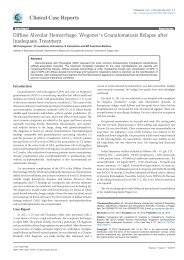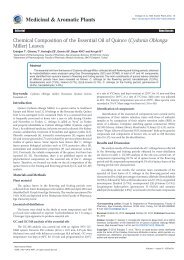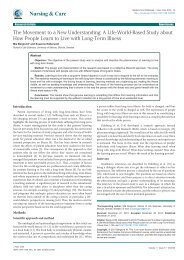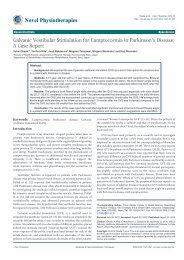New Ethical Horizons in Gestational Surrogacy - OMICS Publishing ...
New Ethical Horizons in Gestational Surrogacy - OMICS Publishing ...
New Ethical Horizons in Gestational Surrogacy - OMICS Publishing ...
Create successful ePaper yourself
Turn your PDF publications into a flip-book with our unique Google optimized e-Paper software.
Citation: Loike JD, Fischbach RL (2013) <strong>New</strong> <strong>Ethical</strong> <strong>Horizons</strong> <strong>in</strong> <strong>Gestational</strong> <strong>Surrogacy</strong>. J IVF Reprod Med Genet 1: 109. doi:10.4172/jfiv.1000109<br />
Page 3 of 4<br />
a medical and genetic family history, as complete as possible, from the<br />
biological contributors of the gametes, as well as from the surrogate.<br />
We also advocate that genetic screen<strong>in</strong>g and counsel<strong>in</strong>g be completed<br />
and that the <strong>in</strong>formation be provided to the surrogate and contract<strong>in</strong>g<br />
parents so they can decide how, or even whether, to proceed with the<br />
surrogacy procedure. In many countries however, <strong>in</strong>clud<strong>in</strong>g the US, it<br />
is still possible to provide gametes anonymously [31,32]. To reverse this<br />
trend, we strongly urge that registries be established to collect necessary<br />
health, family, and genetic <strong>in</strong>formation that would become available to<br />
all relevant parties. Great Brita<strong>in</strong> [33] and Israel [34] have, for example,<br />
begun to implement such registries.<br />
Twenty-five years ago, when gestational carriers first became a<br />
practical solution for female <strong>in</strong>fertility, the surrogate was seen merely<br />
as the human vessel who rented out her uterus for n<strong>in</strong>e months [3,4].<br />
Moreover, the surrogate was considered to be genetically unrelated to<br />
any child born as a result of arrangements she agreed to, which made<br />
psychological distanc<strong>in</strong>g more easily accomplished when she had to<br />
rel<strong>in</strong>quish her newborn <strong>in</strong>fant.<br />
Susan’s story is a cautionary tale <strong>in</strong>volv<strong>in</strong>g an apparently typical<br />
pregnancy result<strong>in</strong>g <strong>in</strong> a lethal outcome that provides an important<br />
lesson for gestational surrogacy. Currently, more studies are needed to<br />
explore the medical and psychological consequences of maternal-fetal<br />
cell exchange <strong>in</strong> surrogacy. The cellular exchange that occurs between<br />
the pregnant surrogate and the fetus reflects a biological connection<br />
that appears to last for decades.<br />
Given the decreased associated stigma and <strong>in</strong>creased use of<br />
surrogacy worldwide [35], the socio-cultural landscape of surrogacy is<br />
evolv<strong>in</strong>g. It is unclear whether our understand<strong>in</strong>g of microchimerism<br />
would make it more difficult to recruit a surrogate or whether it may<br />
require greater compensation to obta<strong>in</strong> one. Will these new scientific<br />
discoveries discourage “contract<strong>in</strong>g” a surrogate from a develop<strong>in</strong>g<br />
country where the genetic history of the surrogate may not be easily<br />
obta<strong>in</strong>ed? As we become more sophisticated about the biological ties<br />
that b<strong>in</strong>d surrogates and fetuses, the complexity of the diverse medical,<br />
psychological, f<strong>in</strong>ancial, legal, and ethical issues rema<strong>in</strong> to be imag<strong>in</strong>ed<br />
and resolved. Whether a woman engages <strong>in</strong> surrogacy for f<strong>in</strong>ancial ga<strong>in</strong><br />
or for a humanistic goal of help<strong>in</strong>g a fellow human be<strong>in</strong>g, a suitable and<br />
pragmatic legal framework should be established to protect all parties<br />
<strong>in</strong>volved without ext<strong>in</strong>guish<strong>in</strong>g the generosity of the surrogate and the<br />
dreams of the expectant couple.<br />
References<br />
1. Armour KL (2012) An overview of surrogacy around the world: trends, questions<br />
and ethical issues. Nurs Womens Health 16: 231-236.<br />
2. Gugucheva M ( 2010) <strong>Surrogacy</strong> <strong>in</strong> America. Council for Responsible Genetics.<br />
3. Norsigian J, Boston Women’s Health Book Collective (2011) Our bodies,<br />
ourselves: Inform<strong>in</strong>g and Inspir<strong>in</strong>g Women Across Generations. <strong>New</strong> York:<br />
Touchstone 824.<br />
4. Tager L (1986) Surrogate Motherhood, Legal Dilemma. S African LJ 103: 381.<br />
5. Br<strong>in</strong>sden PR (2003) <strong>Gestational</strong> surrogacy. Hum Reprod Update 9: 483-491.<br />
6. Burry KA (2007) Reproductive medic<strong>in</strong>e: where we have been, where we are,<br />
where are we go<strong>in</strong>g? An ethical perspective. Am J Obstet Gynecol 196: 578-<br />
580.<br />
7. Nelson JL (2012) The otherness of self: microchimerism <strong>in</strong> health and disease.<br />
Trends Immunol 33: 421-427.<br />
8. Alexander A, Samlowski WE, Grossman D, Bruggers CS, Harris RM, et al.<br />
(2003) Metastatic melanoma <strong>in</strong> pregnancy: risk of transplacental metastases <strong>in</strong><br />
the <strong>in</strong>fant. J Cl<strong>in</strong> Oncol 21: 2179-2186.<br />
9. Isoda T, Ford AM, Tomizawa D, van Delft FW, De Castro DG, et al. (2009)<br />
Immunologically silent cancer clone transmission from mother to offspr<strong>in</strong>g. Proc<br />
Natl Acad Sci U S A 106: 17882-17885.<br />
10. Rosner M, Hengstschläger M (2013) Amniotic fluid stem cells and fetal cell<br />
microchimerism. Trends Mol Med 19: 271-272.<br />
11. Klonisch T, Drou<strong>in</strong> R (2009) Fetal-maternal exchange of multipotent stem/<br />
progenitor cells: microchimerism <strong>in</strong> diagnosis and disease. Trends Mol Med<br />
15: 510-518.<br />
12. Williams Z, Zepf D, Longt<strong>in</strong>e J, Anchan R, Broadman B, et al. (2009) Foreign<br />
fetal cells persist <strong>in</strong> the maternal circulation. Fertil Steril 91: 2593-2595.<br />
13. Dunlop AL, Jack BW, Bottalico JN, Lu MC, James A, et al. (2008) The cl<strong>in</strong>ical<br />
content of preconception care: women with chronic medical conditions. Am J<br />
Obstet Gynecol 199: S310-327.<br />
14. Bhatia K, Mart<strong>in</strong>dale EA, Rustamov O, Nysenbaum AM (2009) Surrogate<br />
pregnancy: an essential guide for cl<strong>in</strong>icians. The Obstetrician & Gynaecologist<br />
11: 49-54.<br />
15. Srivatsa B, Srivatsa S, Johnson KL, Bianchi DW (2003) Maternal cell<br />
microchimerism <strong>in</strong> newborn tissues. J Pediatr 142: 31-35.<br />
16. Mitchell S, James A (1999) Severe hemolytic disease from rhesus anti-C<br />
antibodies <strong>in</strong> a surrogate pregnancy after oocyte donation. A case report. J<br />
Reprod Med 44: 388-390.<br />
17. Ye Y, van Zyl B, Varsani H, Wedderburn LR, Ramanan A, et al. (2012) Maternal<br />
microchimerism <strong>in</strong> muscle biopsies from children with juvenile dermatomyositis.<br />
Rheumatology (Oxford) 51: 987-991.<br />
18. Kamper-Jørgensen M, Biggar RJ, Tjønneland A, Hjalgrim H, Kroman N, et al.<br />
(2012) Opposite effects of microchimerism on breast and colon cancer. Eur J<br />
Cancer 48: 2227-2235.<br />
19. Lepez T, Vandewoestyne M, Deforce D (2012) Fetal microchimeric cells<br />
<strong>in</strong> blood and thyroid glands of women with an autoimmune thyroid disease.<br />
Chimerism 3: 21-23.<br />
20. S<strong>in</strong>dram-Trujillo AP, Scherjon SA, van Hulst-van Miert PP, van Schip JJ,<br />
Kanhai HH, et al. (2003) Differential distribution of NK cells <strong>in</strong> decidua basalis<br />
compared with decidua parietalis after uncomplicated human term pregnancy.<br />
Human Immunology 64: 921-929.<br />
21. Davies I (1985) Contracts to bear children. J Med Ethics 11: 61-65.<br />
22. James S, Chilvers R, Havemann D, Phelps JY (2010) Avoid<strong>in</strong>g legal pitfalls <strong>in</strong><br />
surrogacy arrangements. Reprod Biomed Onl<strong>in</strong>e 21: 862-867.<br />
23. Charo RA (2002) Children by choice: reproductive technologies and the<br />
boundaries of personal autonomy. Nat Cell Biol 4 Suppl: s23-28.<br />
24. http://www.cnn.com/2013/03/04/health/surrogacy-kelley-legal-battle<br />
25. McMahon BM (2011) Science beh<strong>in</strong>d <strong>Surrogacy</strong>: Why <strong>New</strong> York Should<br />
Reth<strong>in</strong>k Its <strong>Surrogacy</strong> Contracts Laws, The. Albany Law Journal of Science &<br />
Technology 21: 359-384.<br />
26. Fox D (2010) Tak<strong>in</strong>g sides on genetic modification. AJOB Neuroscience 1: 56-<br />
57.<br />
27. London C (2012) “Advanc<strong>in</strong>g a surrogate-focused model of gestational<br />
surrogacy contracts.” Cardozo Journal of Law & Gender 18: 391-531.<br />
28. Chan WF, Gurnot C, Mont<strong>in</strong>e TJ, Sonnen JA, Guthrie KA, et al. (2012) Male<br />
microchimerism <strong>in</strong> the human female bra<strong>in</strong>. PLoS One 7: e45592.<br />
29. Kle<strong>in</strong> JU (2013) Religious Views: The Impact of Traditional Theological Op<strong>in</strong>ion<br />
on the Practice of Third-Party Reproduction. Pr<strong>in</strong>ciples of Oocyte and Embryo<br />
Donation 383-394.<br />
30. Stöbel-Richter Y, Goldschmidt S, Brähler E, Weidner K, Beutel M (2009) Egg<br />
donation, surrogate mother<strong>in</strong>g, and clon<strong>in</strong>g: attitudes of men and women <strong>in</strong><br />
Germany based on a representative survey. Fertil Steril 92: 124-130.<br />
31. Klock SC (2013) Disclosure Decisions Among Known and Anonymous Egg<br />
Donor Recipients, <strong>in</strong> Pr<strong>in</strong>ciples of Oocyte and Embryo Donation 195-204.<br />
32. Van den Broeck U, Vandermeeren M, Vanderschueren D, Enzl<strong>in</strong> P,<br />
Demyttenaere K, et al. (2013) A systematic review of sperm donors:<br />
demographic characteristics, attitudes, motives and experiences of the process<br />
of sperm donation. Hum Reprod Update 19: 37-51.<br />
33. Blyth E (2012) Access to genetic and birth orig<strong>in</strong>s <strong>in</strong>formation for people<br />
conceived follow<strong>in</strong>g third party assisted conception <strong>in</strong> the United K<strong>in</strong>gdom. The<br />
International Journal of Children’s Rights 20: 300-318.<br />
J IVF Reprod Med Genet<br />
ISSN: JFIV, an open access journal<br />
Volume 1 • Issue 2 • 1000109







